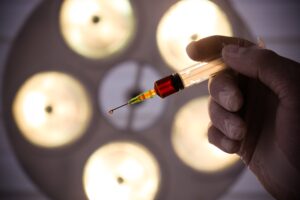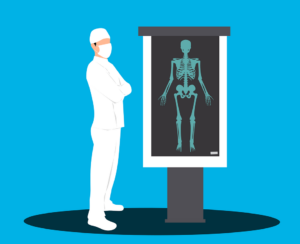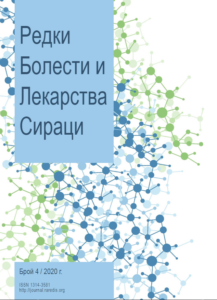 The 11th National Conference for Rare Diseases and Orphan Drugs, organized by the Institute for Rare Diseases, was held on 11-12 September, 2020. The event was held online for the first year, in a specially developed digital platform – Virtual Congress Venue. The conference presented the new and current trends in the diagnosis, treatment and monitoring of rare diseases, the development of European reference networks and access to innovative technologies. A proceedings book with all presentations and materials presented at the conference are published as a supplement to the scientific journal “Rare Diseases and Orphan Drugs” and can be viewed at the following link.
The 11th National Conference for Rare Diseases and Orphan Drugs, organized by the Institute for Rare Diseases, was held on 11-12 September, 2020. The event was held online for the first year, in a specially developed digital platform – Virtual Congress Venue. The conference presented the new and current trends in the diagnosis, treatment and monitoring of rare diseases, the development of European reference networks and access to innovative technologies. A proceedings book with all presentations and materials presented at the conference are published as a supplement to the scientific journal “Rare Diseases and Orphan Drugs” and can be viewed at the following link.
informer
Prospective Analysis in Patients With HAE Under Prophylaxis With Lanadelumab: A Real-life Experience
 Patients with the rare disease hereditary angioedema (HAE) suffer from recurrent acute attacks of edema. There is no curative therapy, but the frequency of attacks and quality of life of severely affected patients can be improved by prophylactic therapy. The monoclonal antibody lanadelumab has been approved for routine prophylaxis in patients with HAE since November 2018. The prospective assessment of this review is initiated by long-term therapy with lanadelumab in 12 adult patients with HAE. It is analyzed their course of disease 6 months after the start of long-term prophylactic therapy using a validated quality-of-life questionnaire and evaluated the frequency and severity of attacks as well as side effects. Furthermore, the therapy with lanadelumab was compared with the previous medication. The result of the research is the first prospective quality of life analysis in HAE patients under treatment with lanadelumab in real life conditions. Mean attack frequencies were reduced from 6.4 to 0.3 attacks per month. No severe attacks occurred under lanadelumab prophylaxis. In all patients, quality of life increased significantly. Read the whole article here.
Patients with the rare disease hereditary angioedema (HAE) suffer from recurrent acute attacks of edema. There is no curative therapy, but the frequency of attacks and quality of life of severely affected patients can be improved by prophylactic therapy. The monoclonal antibody lanadelumab has been approved for routine prophylaxis in patients with HAE since November 2018. The prospective assessment of this review is initiated by long-term therapy with lanadelumab in 12 adult patients with HAE. It is analyzed their course of disease 6 months after the start of long-term prophylactic therapy using a validated quality-of-life questionnaire and evaluated the frequency and severity of attacks as well as side effects. Furthermore, the therapy with lanadelumab was compared with the previous medication. The result of the research is the first prospective quality of life analysis in HAE patients under treatment with lanadelumab in real life conditions. Mean attack frequencies were reduced from 6.4 to 0.3 attacks per month. No severe attacks occurred under lanadelumab prophylaxis. In all patients, quality of life increased significantly. Read the whole article here.
 This year in Plovdiv Rare Disease Day will be celebrated on 28 February, 2021. The initiative will be held under the motto “We are many, we are strong, we are united”. The main focus of the event is pictures with colorful messages, and the different colors are symbol of the thousands types of rare diagnoses in the world. The initiative is organized jointly with the National Alliance of People with Rare Diseases and the HAE Association (hereditary angioedema). Students from the Professional School of Food Technology – Plovdiv, will also take part in the celebration of this important event.
This year in Plovdiv Rare Disease Day will be celebrated on 28 February, 2021. The initiative will be held under the motto “We are many, we are strong, we are united”. The main focus of the event is pictures with colorful messages, and the different colors are symbol of the thousands types of rare diagnoses in the world. The initiative is organized jointly with the National Alliance of People with Rare Diseases and the HAE Association (hereditary angioedema). Students from the Professional School of Food Technology – Plovdiv, will also take part in the celebration of this important event.
Every year the Rare Disease Day is on the last day of February. The main goal of the campaign is to raise public awareness and the opportunity for timely diagnosis and treatment of those who are affected. The initiative is set up by EURORDIS and the Council of National Alliances for Rare Diseases in 2008 and gradually becoming a global phenomenon. Hundreds of cities take part in this large-scale campaign every year. Due to the pandemic situation, all events will be organized according to the imposed measures.

On 2 March, 2021 at 6:30 pm in hall Varna of the Virtual Congress Venue, psychologist Milena Velinova will present a lecture about “Autism – diagnosis or personal choice”. The webinar is intended for parents and all interested medical professionals, representatives of the academy, health authorities, patient organizations. The lecture concern main topics such as general characteristics and manifestations, diagnostic methods, interaction and approach.
At this link you can register for the event for free.

Acromegaly is a rare disease with a peak of incidence in early adulthood. However, enhanced awareness of this disease, combined with wide availability of magnetic resonance imaging (MRI), has increased the diagnosis of forms with mild presentation, especially in elderly patients. Moreover, due to increased life expectancy and proactive individualized treatment, patients with early-onset acromegaly are today aging. The aim of our study was to describe our cohort of elderly patients with acromegaly.
This is a cross-sectional retrospective study of 96 outpatients. Clinical, endocrine, treatment, and follow-up data were collected using the electronic database of the University Hospital of Padova, Italy.
We diagnosed acromegaly in 13 patients, aged ≥65 years, presenting with relatively small adenomas and low IGF-1 secretion. Among them, 11 patients were initially treated with medical therapy and half normalized hormonal levels after 6 months without undergoing neurosurgery (TNS). Remission was achieved after TNS in three out of four patients (primary TNS in two); ten patients presented controlled acromegaly at the last visit. Acromegaly-related comorbidities (colon polyps, thyroid cancer, adrenal incidentaloma, hypertension, and bone disease) were more prevalent in patients who had an early diagnosis (31 patients, characterized by a longer follow-up of 24 years) than in those diagnosed aged ≥65 years (5 years of follow-up).
Elderly acromegalic patients are not uncommon. Primary medical therapy is a reasonable option and is effectively used, suggesting cost-benefit balance. Disease-specific comorbidities are more prevalent in acromegalic patients with a longer follow-up rather than in those diagnosed aged ≥65 years. Read the whole article here.
A list of authorised orphan medicinal products registered by the UK Licensing Authority.
 Orphan drugs are essential for the prevention, diagnosis and treatment of rare conditions.
Orphan drugs are essential for the prevention, diagnosis and treatment of rare conditions.
The Orphan Register comprises:
- EU marketing authorisations converted into Great Britain marketing authorisations in accordance with paragraph 6(7) of Schedule 33A the Human Medicines Regulations 2012 (as amended) where there is an existing European Union (EU) orphan designation, and the Great Britain marketing authorisation continues in effect with the remaining period of orphan market exclusivity.
- Medicinal products that have received a marketing authorisation with orphan status on or after 1 January 2021 from the UK Licensing Authority, the MHRA. Under regulation 58D of the Human Medicines Regulations 2012 (as amended), a period of 10 years orphan market exclusivity is awarded from the date of marketing authorisation by the MHRA. An additional two years of exclusivity may be added where paediatric data requirements have been met.
This is in accordance with regulation 58C(2) of the Human Medicines Regulations 2012 (as amended).
The scope of orphan market exclusivity is defined by the authorised indication.
Products with an orphan designation in the EU can be considered for a Great Britain orphan marketing authorisation.
A UK-wide orphan marketing authorisation can only be considered in the absence of an active EU orphan designation.
There is no pre-authorisation orphan designation in Great Britain.
An orphan designation effective in Great Britain or UK is reflected in PLGB or PL, respectively, in the orphan designation number.
More information can be found on the following link.
 Movement disorders are often a prominent part of the phenotype of many neurologic rare diseases. In order to promote awareness and diagnosis of these rare diseases, the International Parkinson’s and Movement Disorders Society Rare Movement Disorders Study Group provides updates on rare movement disorders.
Movement disorders are often a prominent part of the phenotype of many neurologic rare diseases. In order to promote awareness and diagnosis of these rare diseases, the International Parkinson’s and Movement Disorders Society Rare Movement Disorders Study Group provides updates on rare movement disorders.
In this narrative review, we discuss the differential diagnosis of the rare disorders that can cause chorea.
Although the most common causes of chorea are hereditary, it is critical to identify acquired or symptomatic choreas since these are potentially treatable conditions. Disorders of metabolism and mitochondrial cytopathies can also be associated with chorea.
The present review discusses clues to the diagnosis of chorea of various etiologies. Authors propose algorithms to help the clinician in the diagnosis of these rare disorders. Read the whole article here.
 Myasthenia gravis (MG) is a prototype autoimmune disease that leads to characteristic fatigue and weakness of the ocular, bulbar and respiratory muscles, as well as of the body’s and limbs’ muscles. According to the affected muscle groups, MG is divided into ocular and generalized forms. The modified Osserman scale is often used to evaluate the disease severity. Depending on the age of onset of symptoms, MG is classified into adult MG, juvenile MG and congenital myasthenic syndromes.
Myasthenia gravis (MG) is a prototype autoimmune disease that leads to characteristic fatigue and weakness of the ocular, bulbar and respiratory muscles, as well as of the body’s and limbs’ muscles. According to the affected muscle groups, MG is divided into ocular and generalized forms. The modified Osserman scale is often used to evaluate the disease severity. Depending on the age of onset of symptoms, MG is classified into adult MG, juvenile MG and congenital myasthenic syndromes.
Research on MG epidemiology is an important task as its diagnosis calls for multidisciplinary collaboration between medical professionals from different specialties. MG patient population is heterogeneous in age. Comorbidities in adult patients are frequently observed. The deteriorating prognosis of MG requires a precise and extensive study of this pathology.
This article aims to analyze the epidemiological data on MG, estimate MG’s prevalence in Bulgaria and to present the patient pathway with emphasis on key steps and critical challenges. Read the whole article here.
Clinical presentation and genetic correlations of two Bulgarian patients with mutations affecting the SPATA 5 gene
 Epilepsy, hearing loss, mental retardation syndrome (EHLMRS, OMIM 616577) is a rare disorder due to mutations in the SPATA5 gene on chromosome 4q28 with an AR inheritance. EHLMRS is characterized by intellectual disability, intractable epilepsy, microcephaly, abnormal muscle tone and sensorineural hearing loss. Most affected individuals are nonambulatory, cannot sit unassisted, and have no speech development. More variable features include feeding difficulties, poor growth, cortical visual impairment, spasticity, scoliosis, immunodeficiency and thrombocytopenia.The authors report two clinical cases with EHLMRS and a new likely pathogenic disease causing missense variant c.1831C>T of the SPATA5 gene. Read the whole article here.
Epilepsy, hearing loss, mental retardation syndrome (EHLMRS, OMIM 616577) is a rare disorder due to mutations in the SPATA5 gene on chromosome 4q28 with an AR inheritance. EHLMRS is characterized by intellectual disability, intractable epilepsy, microcephaly, abnormal muscle tone and sensorineural hearing loss. Most affected individuals are nonambulatory, cannot sit unassisted, and have no speech development. More variable features include feeding difficulties, poor growth, cortical visual impairment, spasticity, scoliosis, immunodeficiency and thrombocytopenia.The authors report two clinical cases with EHLMRS and a new likely pathogenic disease causing missense variant c.1831C>T of the SPATA5 gene. Read the whole article here.
 Chromosomal aberrations are the underlying cause in more than half of the early spontaneous abortions, with the greatest part being due to autosomal trisomies in particular.We are presenting a case of a couple, consulted in regards to a spontaneous abortion in 5th gestational week that is second consecutive abortion with the current partner and third consecutive pregnancy. Cytogenetic analysis on cultivated fibroblasts from abortive material was performed, examining 11 metaphases plates with the use of the GTG-banding technique. Lymphocytic cultures from both parents were also analysed in order to exclude balanced chromosomal rearrangements.It was established that the foetus had 47,XY,+16 karyotype, a complete form, with 150 bands resolution. The cytogenetic analysis of the parents confirmed normal karyotype – 46,XX for the mother and 47,XY,22pstk+ps+ for the father, with 400-550 bands resolution, GTG-banding. Аn incompatible with life sporadic mutation is confirmed in the fetus, that occurred either during gametogenesis or very early in the ontogenetic development. The risk for reoccurrence is considered low, equal to the risk in the general population.The current publication aims to demonstrate the contemporary application of the cytogenetic analysis in clarification of the aetiology of spontaneous abortions and the related genetic consultation in such cases. Given the advance in molecular-genetic techniques, which are unfortunately not yet offered massively enough in the country, this is a well-known, economically convenient and not so rarely performed method in spite of its disadvantages. Read the whole article here.
Chromosomal aberrations are the underlying cause in more than half of the early spontaneous abortions, with the greatest part being due to autosomal trisomies in particular.We are presenting a case of a couple, consulted in regards to a spontaneous abortion in 5th gestational week that is second consecutive abortion with the current partner and third consecutive pregnancy. Cytogenetic analysis on cultivated fibroblasts from abortive material was performed, examining 11 metaphases plates with the use of the GTG-banding technique. Lymphocytic cultures from both parents were also analysed in order to exclude balanced chromosomal rearrangements.It was established that the foetus had 47,XY,+16 karyotype, a complete form, with 150 bands resolution. The cytogenetic analysis of the parents confirmed normal karyotype – 46,XX for the mother and 47,XY,22pstk+ps+ for the father, with 400-550 bands resolution, GTG-banding. Аn incompatible with life sporadic mutation is confirmed in the fetus, that occurred either during gametogenesis or very early in the ontogenetic development. The risk for reoccurrence is considered low, equal to the risk in the general population.The current publication aims to demonstrate the contemporary application of the cytogenetic analysis in clarification of the aetiology of spontaneous abortions and the related genetic consultation in such cases. Given the advance in molecular-genetic techniques, which are unfortunately not yet offered massively enough in the country, this is a well-known, economically convenient and not so rarely performed method in spite of its disadvantages. Read the whole article here.
